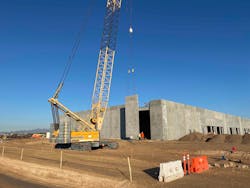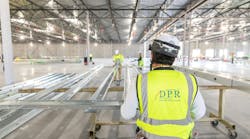Building Greener: Compass Seeks Sustainability in its Construction, Supply Chain
There’s been plenty of focus on how companies can sustainably power and operate their data centers. But how about how these massive cloud campuses are built?
Compass Datacenters says that small changes in the construction process can make a huge difference in the environmental impact of a data center.
“The construction industry is responsible for close to 50% of greenhouse gas emissions,” said Nancy Novak, Chief Innovation Officer at Compass Datacenters. “What an opportunity! Small changes in our industry mean big changes globally.”
"We need to focus on means and methods (of construction),” said Chris Crosby, the CEO of Compass. “The way you improve economic models is through tiny little steps, with continuous improvement on an ongoing basis.
“These improvements may be 1% or 2% or 3% (reductions),” he added. “But they add up. We love incremental gain.”
Crosby and Novak spoke about Compass’ pursuit of innovation in construction at the Data Center BUILD event, held earlier this year as part of the Data Center World conference in Austin.
As it has grown into one of the world’s leading builders of data center space, Compass hasn’t been afraid to look beyond the status quo, pursuing sustainable options in everything from the concrete and steel that support its data center structures to the fuels that power its generators.
Bringing the Supply Chain On-Campus
The developer has even brought its supply chain to its construction sites.
"Compass uses batch plants for concrete on our campus, which eliminates truck rolls,” said Novak. The impact is meaningful, as Compass uses 17,000 cubic yards of concrete on each of the 10 “Moonraker” data centers being built at its Red Oak, Texas campus.
Cement production is responsible for roughly 7% of global carbon dioxide emissions. Compass partners with CarbonCure Technologies to reduce the environmental impact of its concrete, which can reduce the developer’s CO2 footprint by an average of 1,800 tons per campus. Compass amplifies that savings by bringing its CarbonCure operation on site.
“We can take thousands of ready-mix trucks off the road and not transport the concrete 30 miles to and from by controlling it here on site,” Novak noted in a recent video with our colleague Bill Kleyman.
“This is a simple thing our industry can do,” said Novak. “We have lots of these big campuses."
Compass is also working with Schneider Electric to create an integration facility adjacent to its campus in Red Oak. It will include a UPS testing center, and integrate power modules, data hall components and modular data centers.
Crosby said the new facility “reflects the changing dynamics of data center supply chains and the competitive need for more tightly integrated vendor/supplier partnerships. The integration facility will assemble and deliver power centers for Compass facilities and will enhance our supply chain reliability, speed to market and delivery schedule integrity."
Compass says its speed-to-market strategy is not just about customer satisfaction – it has a sustainability component.
“If you go faster, you can reduce the carbon from the project,” said Novak.
A Pioneer in Cleaner Generator Fuel
Compass was the first data center operator to work with CarbonCure, and the first in the U.S. to begin using hydrogenated vegetable oil (HVO) in place of diesel fuel on its
Testing shows the use of HVO can reduce the greenhouse gas emissions from its generators by as much as 85 percent. That’s why HVO is emerging as an important bridge to cleaner backup power, allowing data centers to move off of diesel fuel without having to replace thousands of generators that are both expensive and mission-critical. HVO can be used as a direct replacement for diesel or can be blended with diesel.
But there are many barriers to adoption. HVO remains much more expensive than diesel fuel, and lacks a national pipeline network for deliveries. Crosby says that market demand can solve these problems, but someone needs to go first.
“We have made a full commitment that we deploy HVO fuel,” he said. “Right now, it’s more than two times the cost of diesel. All we need is for the industry to adopt this and the price goes way lower. If everyone went to HVO fuel, we’d get pipelines. And how much less emissions would there be?”
“We’re here to show that we’re using it and it works,” said Wayne Watson, the VP of North America Operations for Compass, in a session at last fall’s 7x24 Exchange conference. “It’s really a call to action for other companies in our industry to use HVO. Until those orders are placed, we’ll keep going. But we expect things to change."
“It’s tough to pay more for fuel for our generators because it’s the right thing to do,” said Watson. “But it IS the right thing to do. We want people to use HVO.”
Adoption is growing in Europe, where Amazon Web Services, Digital Realty and Kao Data are using HVO, and Microsoft is using a form of biodiesel. In North America, STACK Infrastructure and Equinix have tested HVO in some of their facilities.
Compass seeks incremental gains in sustainability across its construction operation, Crosby said. That includes:
- Using Fiberglass Reinforced Polymers (FRP) in place of steel. FRP is a strong composite material that resists corrosion, and is also being used by Aligned Datacenters.
- Adopting helical piers in place of concrete slabs and footings in some data center builds. Helical piers are like large screws that are installed in the ground below the frost line to provide structural support.
- Examining more sustainable materials to get the most efficient temperature management in ducting and piping materials for data centers.
Thinking in 100-Year Timelines
The data center industry has a long track record of innovation, which often moves faster in software and hardware than in the trades. As a result, Crosby sees lots of opportunity for continuing improvement.
“Data centers don't need to be built like snowflakes all the time,” he said. “You can optimize a site for 'what's the best way for me to build on this site.'”
Sustainability also requires thinking differently about the lifespan of a project.
“Are you thinking in 100-year timelines?” Crosby said in his keynote address at BUILD. “If you're thinking about sustainability, you should be. Are data center campuses ever going to go away? Think about how many enterprises have 35- to 40-year-old data centers that are still kicking.”
Novak has a long history of thought leadership in applying new technology and methodologies to make construction faster, cheaper, safer and more efficient. She says the data center sector has an opportunity to pioneer sustainable infrastructure across the world. She notes that Africa could support up to 350 megawatts of new data center construction.
"That's basically a blank slate," said Novak. “Digitizing everything is changing the way we live. There's lots of new normals in today's world. These data centers are being built at such a rapid pace."
“This is a noble profession,” said Novak. “How do we do this better? We've got work to do. It's incumbent on us to figure this out.”
About the Author



